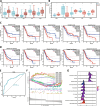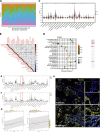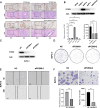Integrated bioinformatics analysis identifies PCSK9 as a prognosticator correlated with lipid metabolism in pancreatic adenocarcinoma
- PMID: 39342295
- PMCID: PMC11439283
- DOI: 10.1186/s12957-024-03532-0
Integrated bioinformatics analysis identifies PCSK9 as a prognosticator correlated with lipid metabolism in pancreatic adenocarcinoma
Abstract
Background: Pancreatic adenocarcinoma (PAAD) is the most frequent kind of pancreatic cancer (PC). Recent studies suggest that lipid metabolism facilitates tumorigenesis, disease progression, and resistance to therapy by promoting lipid synthesis, accumulation, and breakdown. Thus, exploring the lipid metabolism network could unveil novel therapeutic avenues for early detection, precision medicine, and prognostication in PAAD. This project intends to develop new lipid metabolism-related biomarkers for PAAD diagnosis and investigate the link between important genes and immune cell infiltration (ICI).
Methods: Tissue samples from 20 PAAD patients and 20 healthy controls were obtained. Analysis were focused on the datasets GSE71729 and GSE16515, which include samples of PAAD (n = 161) and those from healthy human tissue (n = 61), derived from the GEO database. Knockdown of PCSK9 on PC cells were conducted by si-RNA and sh-RNA. Migration and cell functional experiments were performed to assess the role of PCSK9 in cell multiplication. Furthermore, a xenograft mouse model was employed to confirm PCSK9's function in vivo.
Results: The expression level of Proprotein convertase subtilisin/kexin type 9 (PCSK9) is significantly elevated in tissues affected by PAAD when compared to normal tissues. Survival analyses indicated that increased PCSK9 levels are inversely related to overall and disease-free survival (DFS). PCSK9's functional annotation associated it with the cell cycle and metabolism, especially energy metabolism. Examination of ICI data determined that PCSK9 expression demonstrated an unambiguous association with the M0 macrophages, T follicular helper cells (Tfh), gamma delta T cells and activated DC, and an inverse relationship with Monocytes, CD8+ T cells, memory B cells, resting CD4+ memory T cells, activated NK cells and resting DC abundance. PCSK9 expression knockdown has the ability to impede PC cells' migration and proliferation.
Conclusion: Our study identified PCSK9 as a critical gene in PAAD. Expression levels of PCSK9 varied between PAAD and normal samples. ROC analysis verified PCSK9's strong capacity to differentiate PC from normal samples. Importantly, PCSK9 expression was considerably elevated in PC cell lines and tissues. Furthermore, PCSK9 stimulates the migration and proliferation of tumor cells in vivo and vitro.
Keywords: Pancreatic cancer; Proprotein convertase subtilisin/kexin type 9; Tumor immunotherapy; Tumorigenesis and progression.
© 2024. The Author(s).
Conflict of interest statement
The authors declare no competing interests.
Figures






Similar articles
-
Exploring the functional and prognostic roles of EPHX4 in pancreatic cancer: Insights from bioinformatics and experimental validation.Gene. 2025 Aug 5;959:149504. doi: 10.1016/j.gene.2025.149504. Epub 2025 Apr 19. Gene. 2025. PMID: 40258406
-
Identification of a novel prognostic marker ADGRG6 in pancreatic adenocarcinoma: multi-omics analysis and experimental validation.Front Immunol. 2025 Mar 27;16:1530789. doi: 10.3389/fimmu.2025.1530789. eCollection 2025. Front Immunol. 2025. PMID: 40226617 Free PMC article.
-
Overexpression of CBX3 in Pancreatic Adenocarcinoma Promotes Cell Cycle Transition-Associated Tumor Progression.Int J Mol Sci. 2018 Jun 14;19(6):1768. doi: 10.3390/ijms19061768. Int J Mol Sci. 2018. PMID: 29903985 Free PMC article.
-
Identify potential prognostic indicators and tumor-infiltrating immune cells in pancreatic adenocarcinoma.Biosci Rep. 2022 Feb 25;42(2):BSR20212523. doi: 10.1042/BSR20212523. Biosci Rep. 2022. PMID: 35083488 Free PMC article. Review.
-
Proprotein convertase subtilisin/kexin type 9 (PCSK9) in the central nervous system.Neurosci Biobehav Rev. 2023 Jun;149:105155. doi: 10.1016/j.neubiorev.2023.105155. Epub 2023 Apr 3. Neurosci Biobehav Rev. 2023. PMID: 37019248 Review.
Cited by
-
PCSK9 Manipulates Lipid Metabolism and the Immune Microenvironment in Cancer.Onco Targets Ther. 2025 Mar 27;18:411-427. doi: 10.2147/OTT.S504637. eCollection 2025. Onco Targets Ther. 2025. PMID: 40166624 Free PMC article. Review.
-
PCSK9 expression and cancer survival: a prognostic biomarker at the intersection of oncology and geroscience.Geroscience. 2025 Jun 27. doi: 10.1007/s11357-025-01733-3. Online ahead of print. Geroscience. 2025. PMID: 40576911
References
-
- Siegel RL, Miller KD, Wagle NS, Jemal A. Cancer statistics, 2023. CA Cancer J Clin. 2023;73(1):17–48. - PubMed
-
- Rahib L, Smith BD, Aizenberg R, Rosenzweig AB, Fleshman JM, Matrisian LM. Projecting cancer incidence and deaths to 2030: the unexpected burden of thyroid, liver, and pancreas cancers in the United States. Cancer Res. 2014;74(11):2913–21. - PubMed
MeSH terms
Substances
LinkOut - more resources
Full Text Sources
Medical
Research Materials
Miscellaneous

